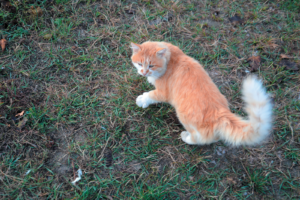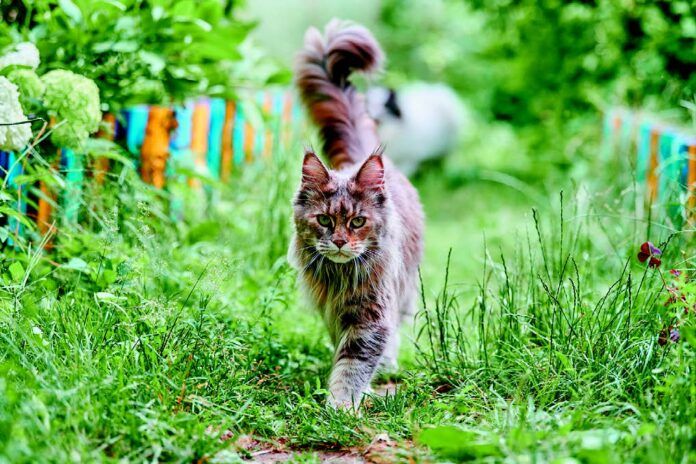While cats don’t speak our language, there is the language of their bodies, and it can tell us a lot about how they’re feeling. One of the most “expressive” feline body parts is the tail. Here’s how to “translate” its movements and positioning.
Erect tail. When a cat’s tail is stretched high and out to its full length, chances are your pet is in a pretty good mood. Consider it a greeting, an invitation to stroke him, or perhaps a request for food. If you notice a curve in the tail that resembles a question mark, your pet might be in a particularly good mood and looking for some interactive fun.
Flicking tail. If a cat’s tail is flicking, particularly when he’s seated, there’s a good chance he’s feeling irritated. Don’t push it just then. You might notice this after you’ve been petting him for a while.
Tail down. A tail held in the down position (with the behind elevated) is not a good sign. It often means the cat is feeling aggressive. It certainly means his mood is serious. You might see it when a cat is standing sideways to another cat.
Tucked tail. A tailed tucked between the legs implies just what you might think it does: fear. Your cat needs to be protected from whatever he feels is threatening him.

© ArchitectPhd | Bigstock
Puffed-up tail. Fluffed up and arched, the tail is sending a signal that the cat feels alarmed and intends to act either aggressively or defensively. If the fluffed tail is straight out or down, aggressive behavior might very well follow.
Wagging tail. A wagging tail can be hard to read. Small flicks can mean anything from indecision to annoyance, or outright anger that could turn aggressive. That’s especially true if the flicks appear pronounced and deliberate. You can also think of a wagging tail as something of a metronome. A fast back-and-forth is probably about a bad mood. A slow swishing, on the other hand, could just mean your cat is focusing. You might see it just before your pet pounces on a toy.
Tail wrap. When a cat wraps his tail around another cat, it means just what it looks like. The two felines are buddies. It’s like someone putting his arm around another person. But if a cat wraps his tail around his own body, it means he is feeling insecure — or perhaps even unwell. If it goes on for more than a few days, a vet visit is in order.
Some (but not all) cats like being scratched near the base of the tail — for a short time. There’s a large concentration of nerves there, so it’s easy for the pleasurable sensation to become overkill — like too much tickling. Take your cue from your pet. If he likes to be scratched there, stop before it goes too far and he ends up letting you know aggressively. If he wants more, he’ll let you know.





My cat is a very hyper player. She wants to play she will do “Halloween cat” . Back arched, all the fur puffed out except for the tip pf her tail which flops over. She hops in that pose. We will stand up spread our arms and roar. She runs full tilt all through the house then hide We have to look for her, she will jump out grab out ankles and take off again. She will lay down when she is done and purred like mad. One nutty cat.